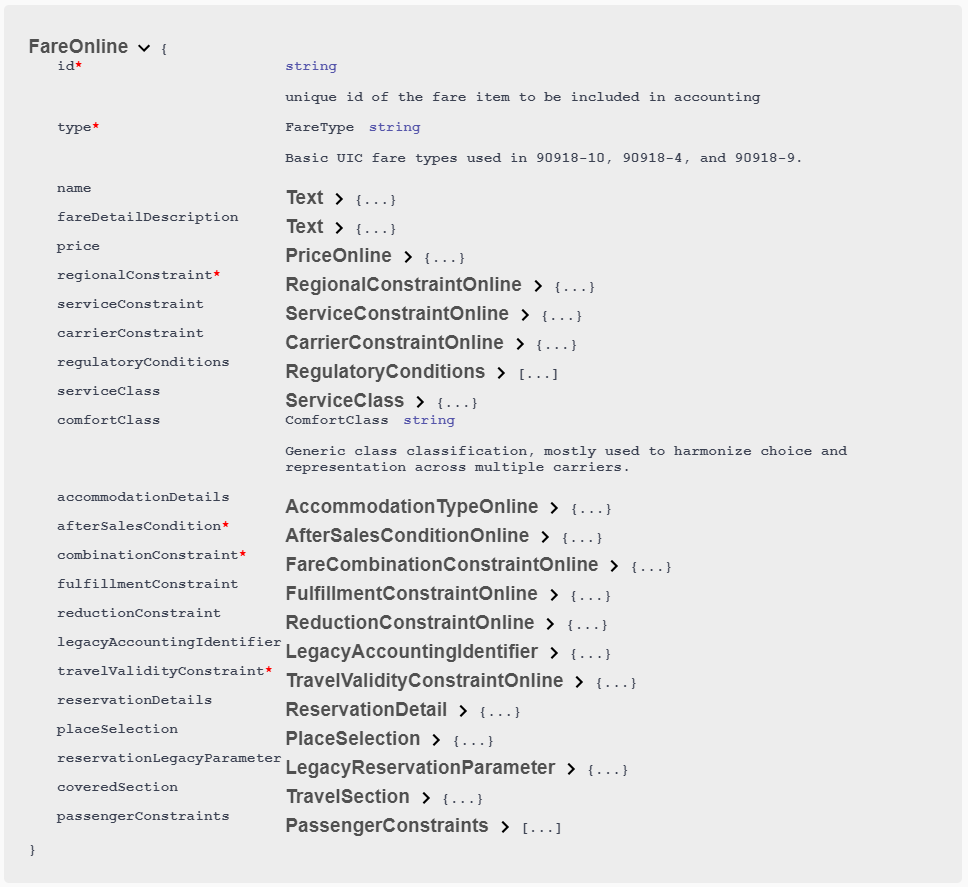Table of contents
- Ways to Access Fares
- Attributes of an Online Fare
- Roles of Fare Attributes in the Booking and After Sales Processes
- After Sale
Relationships between Offers, OfferParts, Products and Fares
The entities offer, offerpart, product and fare represent different
concepts.
An offer spans the trip consisting of segments. An offerpart spans a segment
or - in the case of through fares - multiple segments. An offerpart references
zero or two products. Mostly, the relationship is one-to-one (zero in case of
included seat reservation, whereas two products are only referenced in some rare
TGV-TER scenarios).
A fare is not necessarily bound to segments but reflects the tariff worlds. A
fare often starts or ends at country borders where no train station exist.
This border points are thus called virtual border points which can be modelled
by ConnectionPoints. Fares are combined following a fare combination model
to an offer.

Note: This example assumes that the complete trip can be priced.
Ways to Access Fares
There are three ways for a retailer to access fares.
First Scenario: Complete Offline Import of Fares
A retailer imports all fares of a given railway using a batch import from the OSDM-Offline platform.
The fares contain all relevant information to create offers, bookings and fulfillments (aka. tickets). If a booking occurs the RU informs the RU of the fare sold using UIC 301.
Second Scenario: Import of Relevant Fares at Offer Step
At offer time, a retailer looks up the fares for a given origin/destination in its database. If it doesn’t find it the retailer imports the relevant fares online. If a booking occurs the RU informs the RU of the fare sold using UIC 301.
Third Scenario: No Explicit Import of Fares
For a given origin/destination and date of travel the relevant fares are
returned as part of the Offer.
If the fare is sold as part of an offer then the fare is booked online at the offering retailer.
Attributes of an Online Fare

Roles of Fare Attributes in the Booking and After Sales Processes
The fare contains all information so that a retailer can calculate correct prizes, render a valid fulfillment and account correctly.
The following sections describe which fare attributes are used at which step:
Offer Creation Step
Relevant fare attributes for the offer creation step are:
-
price -
regionalConstraintExamples: a list of stations, a list of zones or a list of train link,…
A retailer needs to guarantee that the whole trip is covered by fares.
-
serviceConstraintExamples:
IC,TGV,BEX, …A retailer can create offers only if the trip/segment is run by the service.
-
carrierConstraintExamples: Thalys, Eurostar, …
A retailer can create offers only if the trip/segment is run by the carrier.
-
regulatoryConditionsExamples:
CIV,MDorEU-PERThe regulatory conditions need to be indicated in the offer to inform the customer.
-
serviceClassExamples:
HIGH,BEST,STANDARDorBASICA retailer needs to consider
serviceClassdepending on theFareCombinationModelapplied.The service class needs to be indicated in the offer to inform the customer.
-
travelClassExamples:
FIRSTorSECONDThe comfort class needs to be indicated in the offer to inform the customer.
-
accommodationDetailsExample:
SEAT,COUCHETTE,BERTHorVEHICLEIf the train is a night train or car carriage the accommodation details need to be reflected in the offer.
-
afterSalesConditionExample: Non-refundable after departure.
A retailer needs to consider
afterSalesConditiondepending on theFareCombinationModelapplied.The refund/exchange conditions need to be indicated in the offer to inform the customer.
-
combinationConstraintExamples:
SEPARATE_CONTRACTSmodel,SEPARATE_TICKETSmodel,CLUSTERINGmodel orCOMBINATIONmodelA retailer can only combine fares respecting the combination models.
-
fulfillmentConstraintExamples:
SIP,SIDorSISA retailer can only create offers which respect the constraints concerning the ticket control. If
fulfillmentConstraintare mixed, then all constraints need to be served. -
reductionConstraintExample:
1085_GAwhere 1085 denotes SBB,1080_Bahncard50, where 1080 denotes DB, …A retailer can create offers only if the passenger(s) own(s) the reduction(s).
-
travelValidityConstraintExample: Valid 24h after departure
The travel validity constraint needs to be communicated in the offer to inform the customer.
-
placeSelectionExample: Selected places in a graphical seat map, reference place for adjacent reservation or place preferences
A retailer most respect the selected places. The other types are optional to be respected by the retailer.
-
coveredSectionExample: Start and end location
A retailer has to create an offer that covers the whole trip from start location to end location.
Booking Step
Relevant fare attributes for the booking process step are:
-
price -
reservationDetailsExample: Wagon 19, Seat 44
The reservation details need to be communicated at the pre-booking step to the customer.
-
legacyAccountingIdentifierThe legacy accounting identifier information is used to write a correct 301 record.
Fulfillment Step
Relevant fare attributes for the fulfillment step are:
-
priceThe price needs to be communicated to the passenger(s), e.g. printed on the ticket.
Additionally, it needs to be encoded in the security element(s).
-
regionalConstraintThe regional constraint need to be communicated to the passenger(s), e.g. printed on the ticket.
Additionally, it needs to be encoded in the security element(s).
-
regulatoryConditionsThe regulatory conditions need to be communicated to the passengers(s), e.g. printed on the ticket.
-
reservationsDetailsThe reservation details need to be communicated to the passengers(s), e.g. printed on the ticket.
Additionally, it needs to be encoded in the security element(s) in case of mandatory reservations.
-
serviceClassThe service class need to be communicated to the passengers(s), e.g. printed on the ticket.
Additionally, it needs to be encoded in the security element(s).
-
travelValidityConstraintThe date are needed to create valid barcode and control data.
Additionally, it needs to be encoded in the security element(s).
-
passengerConstraintExample: Age between 6 and 16 years
The passenger constraint need to be communicated to the passengers(s), e.g. printed on the ticket.
After Sale
Refund Offer Creation Step
Relevant fare attributes for the creation of a refund offer are:
-
price -
afterSaleConditionsA retailer can create offers only if the after sale condition support its creation.
Exchange Offer Creation Step
Relevant fare attributes for the creation of a refund offer are the
afterSaleConditions as well as all the attributes for offer creation.